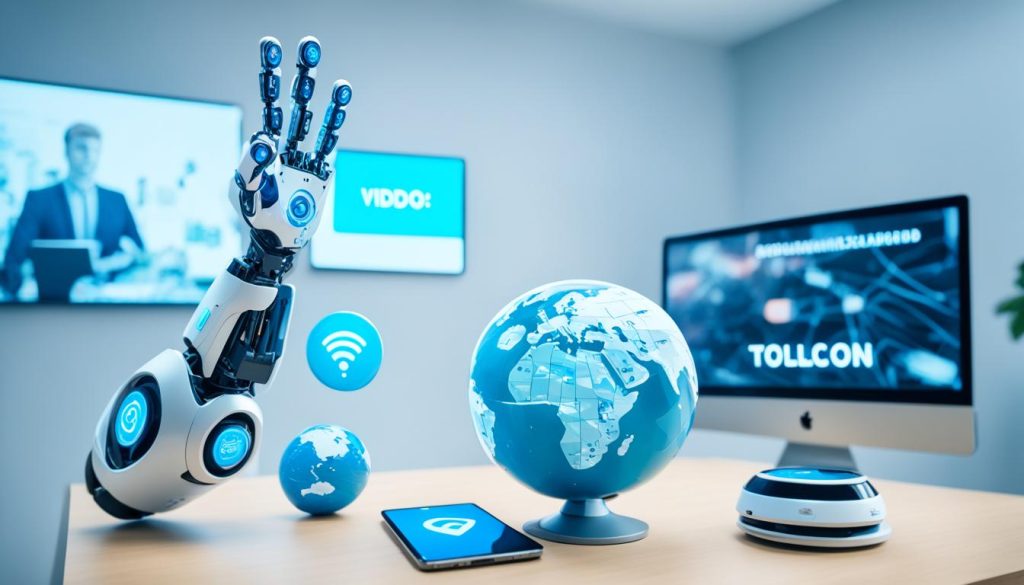In today’s global marketplace, reaching diverse audiences is key. Video localization has become a crucial part of any global content strategy. AI-powered video tools are revolutionizing how businesses create multilingual content, making it easier than ever to connect with viewers worldwide.
These cutting-edge technologies are transforming the way companies approach their international marketing efforts. By leveraging AI in video localization, businesses can efficiently adapt their content to different languages and cultures, ensuring their message resonates with target audiences across borders.
Key Takeaways
- Video localization is essential for global content strategies
- AI-powered tools streamline the localization process
- Multilingual content expands audience reach
- AI enhances efficiency in adapting videos for different markets
- Localized content improves engagement with international viewers
Understanding the Importance of Localized Video Content
Localized video content plays a crucial role in global business expansion. By tailoring videos to specific markets, companies can boost their market penetration and create deeper connections with audiences worldwide.
Cultural adaptation is key to successful localization. Videos that resonate with local customs, values, and preferences are more likely to engage viewers and drive action. This approach goes beyond mere translation, encompassing visual elements, storytelling techniques, and even humor that aligns with target cultures.
Content personalization takes localization a step further. By analyzing viewer data and preferences, businesses can create highly targeted videos that speak directly to individual interests, increasing audience engagement and conversion rates.
“Localized video content is not just about language. It’s about creating an emotional connection with your audience through cultural relevance and personalized experiences.”
The impact of localized video content on market performance is significant:
| Metric | Non-Localized | Localized | Improvement |
|---|---|---|---|
| Viewer Retention | 45% | 72% | 60% |
| Click-Through Rate | 2.3% | 4.8% | 109% |
| Conversion Rate | 1.2% | 3.5% | 192% |
By investing in localized video content, businesses can significantly enhance their global reach, foster stronger audience connections, and drive growth in diverse markets.
The Role of AI in Video Localization
AI-driven localization is revolutionizing how we adapt video content for global audiences. By harnessing advanced technologies, companies can now create culturally relevant videos faster and more efficiently than ever before.
Machine Learning for Content Analysis
Machine learning algorithms analyze video content to identify key elements that need localization. These systems can detect text, images, and even cultural references that might require adaptation. This automated analysis saves time and ensures no important details are overlooked in the localization process.
Natural Language Processing in Translation
Natural language processing powers automated translation tools, making it possible to quickly generate initial translations of video scripts and subtitles. While human oversight is still crucial, NLP significantly speeds up the translation process and improves consistency across large volumes of content.
Computer Vision for Visual Element Adaptation
Computer vision technology plays a vital role in adapting visual elements for different markets. It can identify and flag culturally sensitive imagery, suggest appropriate replacements, and even assist in resizing or repositioning on-screen text to fit different language requirements.
| AI Technology | Function in Video Localization |
|---|---|
| Machine Learning | Content analysis and element identification |
| Natural Language Processing | Automated translation of scripts and subtitles |
| Computer Vision | Visual element adaptation and cultural sensitivity checks |
By combining these AI technologies, video localization becomes a streamlined, efficient process. This integration allows companies to reach global audiences with culturally appropriate content while maintaining brand consistency and message integrity.
Key Benefits of Using AI for Video Localization
AI-powered video localization brings game-changing advantages to content creators. Let’s explore how these tools revolutionize the process, making it more efficient and effective.
Cost-efficiency stands out as a primary benefit. AI tools slash expenses by automating tasks that once required extensive human labor. This reduction in manual work translates to significant savings for businesses of all sizes.
Scalability is another crucial advantage. AI systems can handle multiple projects simultaneously, allowing companies to expand their reach across various markets without proportional increases in resources or time.
Consistency across different languages and cultures is greatly improved with AI. These tools maintain uniform brand messaging and style, ensuring a cohesive global presence.
Time-saving is a notable perk of AI-driven localization. What used to take weeks can now be accomplished in days or even hours, dramatically speeding up content delivery to international audiences.
Accuracy in translations and cultural adaptations sees a marked improvement with AI. Advanced algorithms capture nuances and context, resulting in more natural and culturally appropriate content.
| Benefit | Impact |
|---|---|
| Cost-efficiency | Reduces manual labor expenses |
| Scalability | Enables multi-market expansion |
| Consistency | Maintains uniform brand messaging |
| Time-saving | Accelerates content delivery |
| Accuracy | Improves cultural adaptations |
By leveraging these benefits, businesses can create localized video content that resonates with global audiences more effectively than ever before.
AI Tools for Creating Localized Video Content
The world of video localization has been revolutionized by AI tools. These cutting-edge technologies streamline the process of adapting content for different markets, making it faster and more efficient than ever before.
Automated Translation and Dubbing Tools
Automated dubbing has become a game-changer in video localization. These tools use speech synthesis to create natural-sounding voiceovers in multiple languages. They analyze the original audio, translate the script, and generate new voice tracks that match the original video’s timing and tone.
AI-Powered Video Editing Platforms
AI video editors are transforming the way content creators work. These platforms use machine learning to automate tasks like scene detection, color correction, and even content creation. They can suggest edits based on the video’s style and target audience, making the localization process smoother and more intuitive.
Localization Quality Assurance Tools
Localization QA tools ensure that translated content meets the highest standards. They use AI to check for consistency in terminology, cultural appropriateness, and linguistic accuracy. These tools can flag potential issues and suggest improvements, helping to maintain the quality of localized videos across different markets.
| Tool Type | Key Features | Benefits |
|---|---|---|
| Automated Dubbing | Speech synthesis, script translation | Fast, cost-effective voice localization |
| AI Video Editors | Automated editing, style suggestions | Streamlined workflow, consistent branding |
| Localization QA | Consistency checks, cultural adaptation | High-quality output, reduced errors |
These AI tools work together to create a powerful ecosystem for video localization. By leveraging automated dubbing, AI video editors, and robust localization QA processes, content creators can efficiently produce high-quality, culturally relevant videos for global audiences.
Overcoming Cultural Barriers with AI-Assisted Localization
AI-assisted localization is revolutionizing global marketing by breaking down cultural barriers. This technology enhances cross-cultural communication, ensuring that content resonates with diverse audiences worldwide.
Cultural sensitivity is paramount in any localization strategy. AI tools analyze content for potential cultural missteps, flagging issues that might offend or confuse target audiences. This proactive approach saves time and prevents costly mistakes in global campaigns.
AI’s role in overcoming cultural barriers includes:
- Identifying culturally sensitive content
- Adapting visuals to local preferences
- Adjusting language for regional nuances
- Ensuring appropriate color schemes and symbols
By leveraging AI in localization, brands can maintain their core message while tailoring it to specific cultural contexts. This balance is crucial for successful cross-cultural communication and brand consistency across markets.
“AI-assisted localization is not about replacing human insight, but enhancing it to create truly resonant global content.”
The impact of AI on cultural adaptation in video content is significant:
| Aspect | Traditional Localization | AI-Assisted Localization |
|---|---|---|
| Speed | Slow, manual process | Rapid, automated analysis |
| Accuracy | Prone to human error | High precision in detecting cultural nuances |
| Cost | Expensive, time-consuming | Cost-effective, scalable |
| Consistency | Varies by translator | Uniform approach across projects |
By embracing AI-assisted localization, businesses can craft culturally sensitive content that truly speaks to their global audience, fostering stronger connections and driving international success.
Best Practices for Implementing AI in Video Localization
Effective AI implementation in video localization requires careful planning and execution. By following key best practices, businesses can optimize their localization workflow and achieve better results.

Integrating Human Expertise with AI Tools
Human-AI collaboration is essential for successful video localization. While AI tools excel at automating repetitive tasks, human experts bring cultural insights and nuanced understanding. Combining both ensures high-quality localized content that resonates with target audiences.
Maintaining Brand Consistency Across Localized Content
Brand consistency is crucial when localizing videos for different markets. Use AI tools to analyze brand elements and ensure they remain intact across various languages and cultures. This approach helps maintain a unified brand image while adapting content for local preferences.
Ensuring Data Privacy and Security
Data protection is paramount in video localization. Implement robust security measures to safeguard sensitive information throughout the localization process. Use encrypted systems and restrict access to authorized personnel only.
| Best Practice | Implementation Strategy | Benefits |
|---|---|---|
| Human-AI Collaboration | Assign AI for initial translations, human experts for refinement | Improved accuracy, cultural relevance |
| Brand Consistency | Use AI to analyze and maintain brand elements | Unified brand image across markets |
| Data Protection | Implement encrypted systems, restrict access | Enhanced security, client trust |
By implementing these best practices, businesses can streamline their localization workflow, ensure brand consistency, and protect sensitive data while leveraging the power of AI in video localization.
Case Studies: Successful AI-Driven Video Localization Campaigns
AI implementation examples are transforming video localization, driving global brand expansion and impressive ROI. Let’s explore some remarkable localization success stories that showcase the power of AI in action.
Netflix, a streaming giant, leveraged AI to localize its content for international markets. By using machine learning algorithms to analyze viewing patterns and preferences, Netflix tailored its content recommendations to specific regions. This AI-driven approach resulted in a 20% increase in viewer engagement across non-English speaking markets.
Another standout case is Coca-Cola’s “Share a Coke” campaign. The beverage company used AI to create personalized video ads featuring popular names in different countries. This localization effort led to a 2% increase in sales globally and a 7% rise in Facebook followers.
| Brand | AI Implementation | ROI |
|---|---|---|
| Netflix | Content recommendation localization | 20% increase in viewer engagement |
| Coca-Cola | Personalized video ads | 2% global sales increase, 7% rise in Facebook followers |
Duolingo, the language learning app, used AI to create personalized video lessons for different cultures. This approach resulted in a 50% increase in user retention and a 30% boost in daily active users across various markets.
These case studies highlight the significant impact of AI-driven video localization on global brand expansion and ROI. By embracing AI tools, companies can create more engaging, culturally relevant content that resonates with diverse audiences worldwide.
Future Trends in AI-Powered Video Localization
The landscape of video localization is rapidly evolving with AI advancements. Emerging technologies are paving the way for exciting possibilities in content adaptation across languages and cultures.
Real-time localization is becoming a reality. AI systems can now translate and dub videos on the fly, making content instantly accessible to global audiences. This speed and efficiency open new doors for live events and streaming services.
Personalized content delivery is another trend gaining traction. AI algorithms analyze viewer preferences and tailor localized content accordingly. This customization enhances user engagement and satisfaction across diverse markets.
“AI-driven localization is not just about translation; it’s about creating culturally relevant experiences for viewers worldwide.”
AI advancements are also improving the quality of localized content. Machine learning models can now detect cultural nuances and adapt content more accurately than ever before.
| Trend | Impact | Timeline |
|---|---|---|
| Real-time localization | Instant global content access | 1-2 years |
| Personalized content delivery | Enhanced viewer engagement | 2-3 years |
| Advanced cultural adaptation | Improved content relevance | 3-5 years |
As these technologies mature, we can expect even more sophisticated AI-powered tools to emerge, revolutionizing the video localization industry and bringing global audiences closer together.
Challenges and Limitations of AI in Video Localization
AI tools offer exciting possibilities for video localization, but they come with their own set of challenges. Understanding these AI limitations helps us use these tools more effectively while respecting cultural nuances and ethical considerations.
Nuanced Language and Cultural Contexts
AI struggles with subtle language differences and cultural contexts. Idioms, humor, and local references often get lost in translation. This can lead to awkward or inappropriate content that fails to connect with the target audience.

Human Creativity vs Automation
While AI excels at repetitive tasks, it lacks human creativity. Balancing automation with human input is crucial for producing engaging creative content. Relying too heavily on AI can result in bland, generic videos that fail to capture the essence of a brand or message.
Ethical AI Use in Content Creation
As AI becomes more prevalent in video localization, ethical concerns arise. These include:
- Potential bias in AI algorithms
- Privacy issues with data used to train AI models
- Job displacement for human translators and localization experts
Addressing these challenges requires a thoughtful approach that combines AI capabilities with human oversight and creativity.
Conclusion
AI tools have revolutionized the creation of localized video content. These powerful technologies offer game-changing AI localization benefits, helping businesses reach global audiences with ease. By leveraging machine learning, natural language processing, and computer vision, companies can adapt their videos to different cultures and languages quickly and efficiently.
A solid global content strategy now relies heavily on AI-driven localization. This approach allows brands to maintain consistency while tailoring their message to specific markets. As the future of video marketing unfolds, AI will play an increasingly vital role in breaking down language barriers and cultural differences.
While challenges remain, the potential of AI in video localization is undeniable. As these tools continue to evolve, they will shape the way businesses communicate with audiences worldwide. Embracing AI localization today can give companies a competitive edge in the global marketplace, paving the way for more effective and engaging international marketing campaigns.

